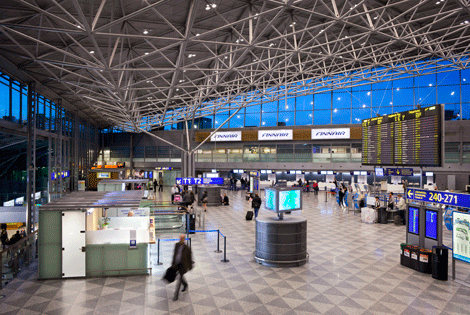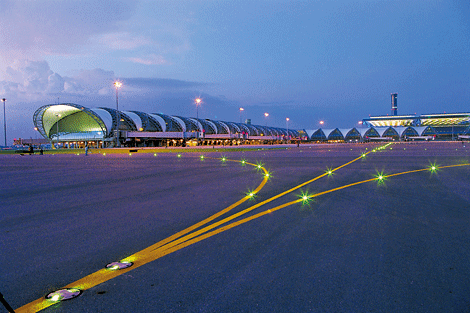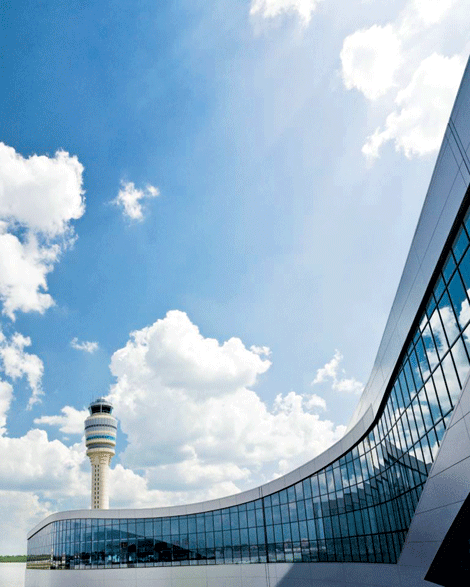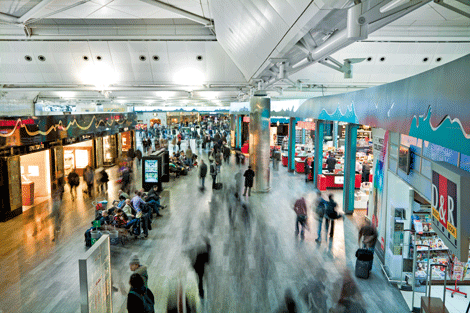Seasoned frequent travellers will all be familiar with connecting to ongoing flights through the stronghold aviation transit hubs of old. Though Changi, Dubai and LAX may have ruled the roost in decades gone by, new competitors have been maximising their strategic advantages and developing their transit facilities. These airports are themselves in transit, on the cusp of becoming major connection points for intercontinental travel.
EUROPE

Helsinki-Vantaa International Airport (pictured above)
Age: 60
2011 traffic numbers: 15 million
Number of airlines: 30+
Destinations served: 130
Minimum connection time: 35 minutes
Strategic advantage: Helsinki-Vantaa provides some of the shortest direct flight times between Europe and Asia because flights to this destination go “over the top” – crossing the Arctic Circle and thus bypassing a chunk of the Earth’s widest curvature that can add hours to flights landing in more southern parts of continental Europe.
Technical facilities: The airport has been maximising its natural advantages as a hub for transit passengers by streamlining the facilities for processing them. A three-storey, €150-million (US$193 million) terminal extension of 39,000 sqm was added in 2009, increasing the airport’s total size by 30 per cent. This has not just allowed for increased capacity, however. The two lower floors are dedicated to a state-of-the-art baggage-handling centre, which has a peak capacity of 7,000 bags an hour. As a result, Helsinki Airport can now process 13.5 million bags a year – an increase of 43 per cent compared to previous capacity.
Between 2009 and 2011 an additional €25 million (US$32 million) of investment covered – among other things – a new security checking system which uses clearer signage, bluetooth congestion notification and other technologies to whittle the procedure down to five or 10 minutes. Electronic border control kiosks have also been installed for EU citizens, which considerably reduces time spent going through immigration.
But it’s not all about practicality at Helsinki Airport: “Experiential services and smooth travel were emphasised in the design of the terminal extension,” says Annika Kala, communications manager of Finavia Corporation. Some of the amenities that fall into this category may include unlimited wifi, an art gallery that recently displayed a fashion design and photography exhibition and a book swap area.
Vienna International Airport
Age: 58
2011 traffic numbers: 21.1 million
Number of airlines: 73
Destinations served: 174
Minimum connection time: 25 minutes
Strategic advantage: With many of the larger airports of continental Europe – such as Heathrow and Charles De Gaulle – struggling with congestion, Vienna is proving a popular alternative with connecting travellers. This trend looks set to continue with the opening of its new Skylink terminal this year, which has doubled the airport’s capacity and allowed for one of the shortest transfer times in the world. In addition to this, Vienna Airport has created an incentive model for airlines that means lower tariffs than the European average.
Technical facilities: The new terminal employs an “entire airport under one roof” concept, with arrivals and departures both housed on three levels and connected vertically – allowing for shorter transfer distances. One of its high-tech features is a self-boarding system where gates make use of mobile phone and WLAN technology to board passengers.
“Details such as these will help support fast, high-quality passenger handling even under the increased traffic conditions, and ultimately provide Vienna International Airport with a significant competitive edge as the East-West hub of choice in central Europe,” says Clemens Schleinzer, the airport’s press liaison officer.
Work has now also started on the modernisation of older terminals. In Pier West, the decentralised security controls have been replaced by a central security control area – a move that has reduced passengers’ waiting time by 90 per cent.
ASIA

Bangkok Suvarnabhumi Airport (pictured above)
Age: Six
2011 traffic numbers: 48 million
Number of airlines: 101
Destinations served: 151
Minimum connection time: 75 minutes
Strategic advantage: Bangkok’s location provides an ideal stopover for connecting the many passengers undertaking the long journey between Australasia and Europe. By building this sizeable new airport six years ago, it has also become the transfer point of choice for many who want to visit the neighbouring countries of Cambodia, Vietnam, the Republic of Laos and Myanmar.
Technical facilities: Being a relatively young airport, most facilities are already state of the art. The huge surface area of the airport does allow for future capacity increase, but some have pointed to this as a disadvantage when it comes to transferring due to the long distances between gates.
In order to combat this, however, a number of updates have been made to existing facilities. This summer the airport began the construction of an entirely separate and dedicated transfer baggage terminal, due to be complete in 18 months. This new facility should speed up the transfer process by 15 minutes, and take minimum connection time down to 60 minutes.
Two new international departure security-screening checkpoints were also opened this summer, increasing capacity to 3,600 passengers per hour – 2.5 times more than previously. They include high-tech equipment such as 3D X-ray scanners for people and their luggage. Anirut Thanomkulbutra, president of Airports of Thailand Plc, commented that this, in particular, “will help speed up the flow and ease congestion of passengers”.
With the THB62.5 billion (US$2 billion) Phase Two airport development project under way and set to begin operation in 2017, this airport looks set to maintain its strong position in the region.
Taipei Taoyuan International Airport
Age: 33
2011 traffic numbers: 24.9 million
Number of airlines: 55
Destinations served: 115
Minimum connection time: 70 minutes
Strategic advantage: Its geopolitical location is the real ace that Taipei’s main airport has up its sleeve. It’s near to, and disputably part of, one of the largest yet most disciplined air spaces in the world: China’s.
Taiwan’s president, Ma Ying-jeou, has acknowledged this, naming its placement at the “centre” of the world’s three biggest economies – the US, Japan and China – as something from which it needs to reap benefits. There have been numerous efforts to this end, with a number of cross-Strait air service agreements gradually being established that grant Taiwan relatively comprehensive access to China’s cities. This gives it the unique ability to service international travellers in and out of these booming metropolises.
“We are allowed to operate point-to-point direct flight between China and Taiwan, which means national carriers of both sides can serve all cities in China to and from Taoyuan Airport,” says Chia-Jui Hsu, director of its planning and marketing department. At the moment, Taoyuan Airport serves 41 destinations in China with more than 600 flights per week. “We expect more cities will be added, especially second-tier cities, and the weekly flights will increase as well in the near future after new agreements are signed by both governments,” Hsu adds.
Technical facilities: Grand plans have been made to accommodate this vision. A NT$384 billion (US$13 billion), eight-year project to create “Taoyuan Aerotropolis” was initiated in 2008, which includes a “Free Trade Port Zone” for international corporate headquarters and a US$1.6-billion third terminal that will take the airport’s capacity up to 43 million.
USA
“Hubbing and spoking originated in the US, so there really hasn’t been much growth there,” says Andy Stephen, general manager of TransAsia Airways. Though his observation may ring true for the majority of big players, the US remains an important market, and one airport in particular demonstrates specific attempts to attract international traffic.

Hartsfield-Jackson Atlanta International Airport (pictured above)
Age: 86
2011 traffic numbers: 92 million
Number of airlines: 31
Destinations served: 225
Minimum connection time: N/A
Strategic advantage: For decades, Atlanta has been a focal point for domestic US transit since it is a two-hour flight from 80 per cent of the country’s population. The Maynard H. Jackson Jr. International Terminal opened in May, allowing for this location to be fully exploited by international travellers as a gateway to connect to more than 150 US cities.
Technical facilities: “The new international terminal is Atlanta’s new front door to the world,” said Richard Anderson, Delta’s chief executive officer. The US$1.4 billion terminal’s main contributions to international transit are that it will eliminate the need for passengers to recheck their baggage, separate purely domestic from international travel, and provide more efficient service.
There has also been much attention paid to enhancing the transit experience. There is an exceptional, 4,000 sqm executive conference centre with 24 meeting rooms and 18 workstations, as well as the Delta Sky Club which includes an art programme and international kids zone.
MIDDLE EAST
“You can almost connect any two cities in the world between the Middle East – that’s the beauty of this location,” observes Stephen. “In terms of the major oceans, the Middle East really is slap bang in the middle of the world.”
The exceptional growth of airports in the region, explored in detail in “Runway Success” in Business Traveller Asia-Pacific’s July/August issue, is testimony to this. Doha’s airport is saturated with passengers, currently operating six million over capacity and is due to open the expansive New Doha International Airport at the end of this year. Abu Dhabi International Airport, meanwhile, added a third terminal and 4,100-metre runway in 2009 and recorded a 21 per cent increase in passenger traffic in the first quarter of this year.
But Stephen points to one of the less obvious hubs in this region as key: “Istanbul is a well-kept secret when it comes to getting to Europe from Asia,” he reveals.

Istanbul Ataturk Airport (pictured above)
Age: 74
2011 traffic numbers: 37.5 million
Number of airlines: 127
Destinations served: 232
Minimum connection time: 45 minutes
Strategic advantage: Historically, Istanbul has served as an intersection between Europe, Asia and Africa for centuries, so its emergence as an international transit hub seems natural. It also has an advantage in geopolitical terms: despite its proximity to Europe (it is, arguably, part of either region) the European Union’s Emissions Trading System does not apply to flights in and out of Turkey.
Technical facilities: Almost 40 per cent of Istanbul Airport’s passenger traffic is in transit, and the airport has slowly been tailoring its facilities to cater to this. A new international terminal was completed in 2000, and since then several extensions have been made to meet growing demand. The most recent was in 2010, when new gates and a new trigeneration plant (combining cooling, heat and power supplies) was added to the international terminal building.
Another transit-friendly feature is the 85-room TAV Airport Hotel, which can be accessed from airside, and rooms are available for hourly and daily bookings. All rooms are equipped with flight information screens, on top of the usual amenities. There are also meeting rooms and a conference hall.
Turkish Airlines’ network expansion also shows no signs of slowing down, either: it is planning to launch a total of 21 new flights this year alone.








